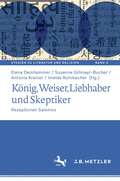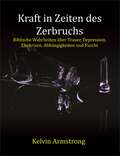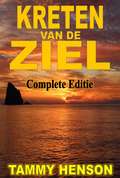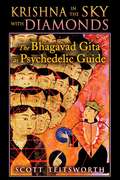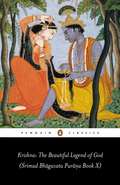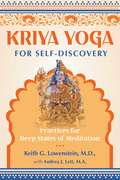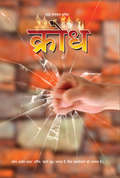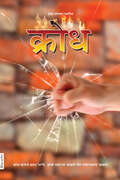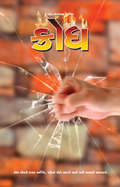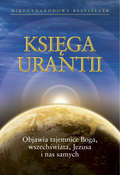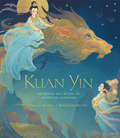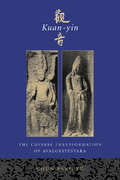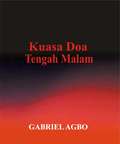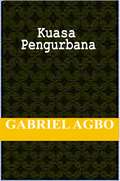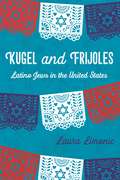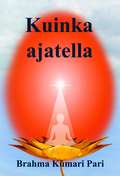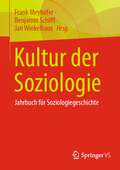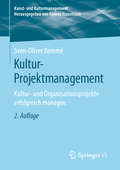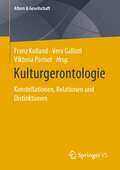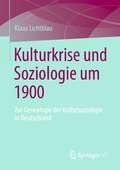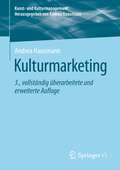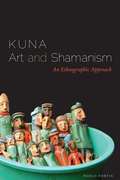- Table View
- List View
König, Weiser, Liebhaber und Skeptiker: Rezeptionen Salomos (Studien zu Literatur und Religion / Studies on Literature and Religion #4)
by Susanne Gillmayr-Bucher Elena Deinhammer Antonia Krainer Imelda RohrbacherKaum eine andere biblische Figur wird so enthusiastisch geschildert wie König Salomo. Er ist unvergleichlich weise, erbaut den Tempel in Jerusalem, und er verhilft auch seinem Volk zu einem Leben in Frieden und Wohlstand. Dennoch scheitert Salomo und erfüllt die in ihn gesetzten Erwartungen letztendlich nicht. Dadurch entsteht ein ambivalentes Bild, das innerhalb des biblischen Kanons und in der späteren Rezeptionsgeschichte vielfältig ausgestaltet wird. Wie facettenreich die Figur Salomos vom 16. bis 21. Jahrhundert in Literatur und Musik entfaltet wird, zeigt dieser Band auf. Die Beiträge im ersten Teil bieten überblicksartige Querschnitten, die Salomo als König, Weisen, Skeptiker und Liebenden in den künstlerischen Bearbeitungen präsentieren. Die Studien im zweiten Teil zeigen am Beispiel ausgewählter Werke, welche Diskurse der jeweiligen Zeit in der Figur König Salomos gespiegelt werden.
Kraft in Zeiten des Zerbruchs: Biblische Wahrheiten über Trauer, Depression, Ehekrisen, Abhängigkeiten und Furcht
by Kelvin ArmstrongKraft in Zeiten des Zerbruchs ist ein inspirierendes christliches Buch, dass dir helfen soll mit den Herausforderungen des Lebens umzugehen, indem du Kraft und Ermutigung aus dem Wort Gottes erhälst. Wenn wir durch schwierige Zeiten gehen, fragen wir uns oft, wieso es gerade uns trifft. Warum hat Gott mich verlassen? Diese Fragen bedrängen uns, wenn wir in Schwierigkeiten stecken. Das Leben macht es uns manchmal sehr schwer und wir versuchen in all dem unseren Weg zu finden. Unser ultimatives Ziel im Leben ist es glücklich zu sein, aber leider ist seit dem Sündenfall alles zu Bruch gegangen. Die Erde ist gebrochen, nichts funktioniert perfekt, selbst unsere Körper, das Wetter, unsere Pläne, unsere Beziehungen, unsere Ehen, nichts funktioniert fehlerfrei, denn das Leben ist von Hochs und Tiefs bestimmt. Vielleicht stehst du Niederlagen und Enttäuschungen gegenüber; vielleicht wurdest du von jemandem betrogen, den du liebst und sehr vertraut hast. So ist das Leben. Wir begegnen Prüfungen, Schwierigkeiten, Leiden, Trauer, Verlust, Einsamkeit, Depression, Ehekrisen, Abhängigkeiten und Ängsten, während wir von einer Phase des Lebens in die Nächste gehen. Aber mitten in all dem was das Leben nach dir wirft, solltest du dich an jemanden anlehnen, jemand der dir helfen kann das durchzuziehen, damit der überwältigende Stress, durch den du im Moment gehen musst, dich nicht um den Verstand bringt. Dieses Buch gibt dir biblische Grundlagen, die dir helfen werden, über die unvermeidlichen Verluste im Leben hinauszuwachsen.
Kreten van de Ziel: Complete Editie
by Tammy HensonDe vrouw in mij groeit. Deze gedichten zijn de diepste gedachten en verlangens van Tammy Henson. Dit boek is specifiek geschreven voor God, christenen en voor de pijnlijke wereld. Zonder God faalt Tammy uiteindelijk. Tammy's diepste roep tot God is voor meer van Hem. Er zijn mensen die wensen en verwachtingen nodig hebben om hoger te gaan. In dit boek zul je Tammy's verlangens zien, hoop op God en op deze wereld. Dit boek is samengesteld uit een serie met twee boeken.
Krishna Ek Rahasya: कृष्ण एक रहस्य
by Ishan Mahesh‘कृष्ण एक रहस्य’ आध्यात्मिक उपन्यास (प्रथम भाग) जब मुझसे लिखा जा रहा था; तब उस पूरे काल में मैंने यह अनुभव किया कि मैं बाँसुरी हो गया हूँ। बाँसुरी होने की आत्मा को मैंने दिव्य रूप में अनुभव किया। मैंने देखा कि उसमें से जो संगीत झर रहा है, वह आ तो मुझमें से होकर तो आ रहा है; किंतु मैं भली-भांति जानता हूँ कि उसमें बहती प्राणवायु मेरी नहीं हैं। जिन अधरों पर यह बाँसुरी रखी है, उसके छिद्रों पर जो अंगुलियाँ नृत्य कर रही हैं और शब्दों का जो महारास हो रहा है-यह सब कृष्ण की विराट ऊर्जा से अनुप्राणित है। इस उपन्यास का आधार कृष्ण और सुदामा की सुप्रसिद्ध पारंपरिक लोक-कथा है। इस कथा में मैंने ध्यान के अनुभवों को समोने का आनंद लिया है। सुदामा को यादव शिरोमणि श्रीकृष्ण के पास उनकी पत्नी ने भेजा तो आर्थिक सहायता प्राप्ति के उद्देश्य से था; किंतु द्वारका पहुँचकर सुदामा ने देखा कि जिस कृष्ण को वे अभी तक अपना बालसखा समझे बैठे थे- वह तो करुणा, प्रेम, भक्ति, न्याय, सत्य, ज्ञान,रस, योग और भोग की पराकाष्ठा हैं। सुदामा बाकि सबकुछ भूल कर कृष्ण की थाह लेने में जुट जाते हैं। अपने इस खोजी अभियान में वे कृष्ण का पार तो पा नहीं पाते; अपितु यह अनुभव करते हैं कि कृष्ण उनकी प्रत्येक श्वास में आ बसे हैं और वे पूर्णतः कृष्णमय हो चुके हैं। कृष्ण उनके मन के उठनेवाले अनेक जटिल प्रश्नों के मौलिक उत्तर देकर उनकी प्यास बुझा रहे हैं। अंततः सुदामा नतमस्तक हो यह स्वीकार कर लेते हैं कि वे कृष्ण के विराट् रूप को बुद्धि के द्वारा तो जान ही नहीं सकते ; किंतु उनके प्रेम की गंगा में नित् स्नान कर आनंदित तो हो ही सकते हैं।
Krishna in the Sky with Diamonds: The Bhagavad Gita as Psychedelic Guide
by Scott TeitsworthA verse-by-verse examination of Arjuna’s soma experience and Krishna’s psychedelic guidance in the Bhagavad Gita • Explains how the Bhagavad Gita provides complete guidelines for the spiritual use of entheogens--from prior mental preparations to the integration of profound visionary insights into everyday consciousness • Examines Chapter XI of the Gita in detail to illuminate Arjuna’s hallucinogenic experience and expose Krishna as the ultimate psychedelic guide • Shows psychedelic experience to be an essential and ancient part of the path to spiritual transformation Known as a text of liberation and enlightenment and praised not only by Indians but also by prominent modern thinkers such as Aldous Huxley and Albert Einstein, the Bhagavad Gita is one of the most commented-upon books of all time, yet one aspect has never before been examined: Arjuna’s psychedelic soma experience with his guru Krishna. Drawing upon his many years as a student of Nitya Chaitanya Yati, whose teacher was Gita scholar Nataraja Guru, preeminent disciple of Narayana Guru, Scott Teitsworth explains how the Bhagavad Gita, through the story of the hero Arjuna and his guru Krishna, provides complete guidelines for the spiritual use of entheogens, from prior mental preparations to the integration of profound visionary insights into everyday consciousness. Examining Chapter XI of the Bhagavad Gita verse by verse, he illuminates Arjuna’s complex revelatory experience and exposes Krishna’s role as the ultimate spiritual guide--facets of the Gita evident to anyone with psychedelic experience yet long suppressed in favor of paths to enlightenment through service or meditation. He shows that psychedelics are indeed “gateway drugs” in that they stimulate open exploration of the mind and the meaning of life. Uncovering new depths to this revered manual of spiritual instruction, Teitsworth reveals psychedelic experience to be an essential and ancient path to ignite realization in the prepared student, turn theory into direct experience, and bring the written teachings to life.
Krishna: Srimad Bhagavata Purana
by Edwin F. BryantThe Purana is one of the two most important and popular Hindu texts, the other being the Ramayana. It is part of the popular tradition, rather than a literary classic like the Upanishads or the Gita. It tells the story of the god Krishna, the supreme godhead of the Hindus and worshipped by them for over two and a half millennia. The most popular stories about him occur in this, the 10th book, which is the climax of the epic. The stories relate to Krishna's childhood and adolescence in the forests of Vrindavan among the herdspeople, delightful tales which lie behind much of Hindu art, appearing in painting, temple sculpture, drama, dance and song.
Kriya Yoga for Self-Discovery: Practices for Deep States of Meditation
by Keith G. Lowenstein• Explains the basic techniques of the practice, detailing proper posture, breathwork exercises (pranayama), bandhas, third-eye gazing, and the use of mantra • Presents advanced, yet simple, techniques that accelerate a contemplative practice by micro-modulations related to posture, respiration, visualization, and sound • Includes wisdom from the author&’s teacher Ganesh Baba on the importance of the spine in Kriya yoga and the Cycle of Synthesis, a model of the human experience Kriya yoga is an ancient meditation technique that focuses on breathing and the spine to unlock deep states of awareness, self-realization, and spiritual growth. Kriya can provide a fast path to awakening, yet its practice has been shrouded in secrecy, passed only from master to initiate for millennia. Introduced into Kriya 40 years ago, Keith Lowenstein, M.D., offers an accessible yet detailed guide to Kriya yoga. He explains the basic techniques of the practice step by step, detailing proper posture, breathwork exercises (pranayama), visualization practices, and mantra. He reveals how Kriya is a scientific art--if practiced consistently, it will allow you to quickly enter deep states of meditation and ultimately experience inner stillness. He also explores how the practice of Kriya leads to healing and the development of compassion and the freeing joy of the union of Nature and Spirit. Sharing the wisdom of his Kriya yoga teacher Ganesh Baba, the author adds a detailed understanding of anatomy, especially the importance of the spine in Kriya yoga and energy flow. The author explores Ganesh Baba&’s teachings on spirit-infused science and the integration of Vedic philosophy, quantum mechanics, prana, and spiritualization illustrated in the Cycle of Synthesis. He also discusses the relationship between the exercises of Kriya yoga and Patanjali&’s Yoga Sutras as well as teachings from his other teachers, including Paramahansa Hariharananda. With this guide, you will gain an understanding not only of the practice of Kriya yoga but also of the spiritual wealth it brings, including the ultimate self-realization of non-dual reality.
Krodh: क्रोध
by Dada Bhagwanहमें क्रोध क्यों आता है? क्रोध आने के कुछ कारण यह है - जब कोई भी कार्य हमारी इच्छानुसार नहीं होता या हमें यह लगे कि सामनेवाला व्यक्ति हमारी बात नहीं समझ रहा या फिर किसी बात पर किसी के साथ मनमुटाव हो तब| लेकिन क्रोध आने का कोई भी निश्चित कारण नहीं होता| कई बार हमारी समझ से हमें यह लगता है कि, हम जो भी सोच रहे है या जो कुछ भी कर रहे है वह सब सही ही है| पर, उस वक्त यदि कोई दूसरा व्यक्ति आकार हमें गलत साबित करे तो हम अपना आपा खो बैठते है और उसपर अत्यंत क्रोधित हो जाते है| क्रोध करने से ना सिर्फ सामनेवाला व्यक्ति दुखी होता है पर हमें भी उतना ही दुःख होता है| कई किस्सों में यह देखा गया है कि जिससे हम सबसे अधिक प्यार करते है, उसपर ही सबसे ज्यादा गुस्सा भी करते हैं| इस तरह बिना सोचा समझे गुस्सा करने से कई बार हमारे संबंधो में भी काफी तनाव पैदा हो जाता है जिसका फल अच्छा नहीं होता| किस प्रकार हम अपने क्रोध पर काबू पा सकते है या किसी और क्रोधित व्यक्ति के साथ कैसा बर्ताव करे ताकि हमारे औरों से प्रेमपूर्वक सम्बन्ध बने रहे, इन प्रश्नों का हल पाने के लिए आगे पढ़े|
Krodh: क्रोध
by Dada Bhagwanहमें क्रोध क्यों आता है? क्रोध आने के कुछ कारण यह है - जब कोई भी कार्य हमारी इच्छानुसार नहीं होता या हमें यह लगे कि सामनेवाला व्यक्ति हमारी बात नहीं समझ रहा या फिर किसी बात पर किसी के साथ मनमुटाव हो तब| लेकिन क्रोध आने का कोई भी निश्चित कारण नहीं होता| कई बार हमारी समझ से हमें यह लगता है कि, हम जो भी सोच रहे है या जो कुछ भी कर रहे है वह सब सही ही है| पर, उस वक्त यदि कोई दूसरा व्यक्ति आकार हमें गलत साबित करे तो हम अपना आपा खो बैठते है और उसपर अत्यंत क्रोधित हो जाते है| क्रोध करने से ना सिर्फ सामनेवाला व्यक्ति दुखी होता है पर हमें भी उतना ही दुःख होता है| कई किस्सों में यह देखा गया है कि जिससे हम सबसे अधिक प्यार करते है, उसपर ही सबसे ज्यादा गुस्सा भी करते हैं| इस तरह बिना सोचा समझे गुस्सा करने से कई बार हमारे संबंधो में भी काफी तनाव पैदा हो जाता है जिसका फल अच्छा नहीं होता| किस प्रकार हम अपने क्रोध पर काबू पा सकते है या किसी और क्रोधित व्यक्ति के साथ कैसा बर्ताव करे ताकि हमारे औरों से प्रेमपूर्वक सम्बन्ध बने रहे, इन प्रश्नों का हल पाने के लिए आगे पढ़े|
Krodh: ક્રોધ
by Dada Bhagwanજયારે પોતાના ધાર્યા પ્રમાણે નથી થતું, અથવા જયારે સામી વ્યક્તિ પોતાને સમજતી નથી, અથવા જયારે દ્રષ્ટિકોણમાં ફરક હોય ત્યારે મોટાભાગે પોતાને ક્રોધ આવે છે. ઘણીવાર આપણને ખોટા માનવામાં આવે છે, જયારે આપણે પોતે સાચા છીએ એમ માનતા હોઈએ ત્યારે આપણને ક્રોધ આવે છે. આપણી પોતાની સમજણના આધારે આપણે પોતાને સાચા માનતા હોઈએ છીએ જયારે સામી વ્યક્તિ માને છે કે તે સાચી છે. મોટાભાગે જયારે આપણને સમજ નથી પડતી કે આગળ શું કરવું, આપણી પાસે દૂરદ્રષ્ટિ કે સૂઝ નથી હોતી ત્યારે આપણે ક્રોધિત થઈએ છીએ. જે લોકો આપણને સૌથી વધારે પ્રેમ કરે છે તેમની સાથેના સંબંધો ને જ આપણે નુકશાન પહોંચાડીએ છીએ. આપણે આપણા સંતાનોને બધા જ સુખચેન, સાથ, સલામતી આપવા માંગીએ છીએ પરંતુ આપણા ક્રોધથી સંતાનો પોતાના જ ઘરમાં ભયભીત રહે છે. ક્રોધિત લોકો સાથે કેમ વર્તવું? જયારે કોઈ યંત્ર બહુ ગરમ થઇ જાય, ત્યારે આપણે તેને થોડા સમય માટે એમજ છોડી દેવું જોઈએ તો તે ટુંક સમયમાં ઠંડું થઇ જશે. પરંતુ જો તમે તેને છેડતા રહેશો તો તમે દાઝશો. તમારા સંબધો અને ક્રોધની સમસ્યાના ઉકેલ માટે આગળ વાંચો.
Krushnayan: કૃષ્ણાયન: માણસ થઈને જીવેલા ઈશ્વરની વાત
by Kajal Oza Vaidyaકૃષ્ણના જીવનની ત્રણ સ્રીઓ। રાધા, રુકિમણી અને દ્રૌપદી પ્રેયસી, પત્ની અને મિત્ર।... માણસ થઈને જીવી ગયેલો ઈશ્વર સાથે પોતાનો મનની વાત કરે છે। અંગ્રેજી, મરાઠી,હિન્દી ભાષામાં અનુવાદિત થયેલી અને ગુજરાતીમાં પાંચ વર્ષમાં અગિયાર આવૃત્તિ જીવી ચુકેલી ધબકતી નવલકથા.
Księga Urantii
by Urantia FoundationKsiega Urantii, po raz pierwszy wydana przez Fundacje Urantii w roku 1955, twierdzi, ze zostala przedstawiona przez niebianskie istoty, jako objawienie dla naszej planety, Urantii.Tekst Ksiegi Urantii mówi nam o poczatkach, historii i przeznaczeniu ludzkosci i naszych zwiazkach z Bogiem Ojcem. Przedstawia jedyny w swoim rodzaju i frapujacy obraz zycia i nauk Jezusa. Przed ludzkim duchem otwiera nowe perspektywy czasu i wiecznosci i przynosi nowe szczególy naszej przygody, podczas wznoszenia sie w przyjaznym i starannie zarzadzanym wszechswiecie.Ksiega Urantii podaje jasna i zwiezla integracja nauki, filozofii i religii. Ci, którzy ja czytali i zglebiali, wierza, ze Ksiega Urantii moze wniesc bardzo wiele wartosci do religijnej i filozoficznej mysli ludzi tego swiata. Ksiega Urantii, jako taka, nie jest religia". Bazuje na religijnym dziedzictwie z przeszlosci i terazniejszosci, popierajac osobista, zywa wiare religijna.Czytelnicy z róznych stron swiata mówia nam, ze Ksiega Urantii wywarla na nich ogromne wrazenie i czestokroc odmienila ich zycie. Inspiruje ich do osiagania nowych poziomów rozwoju duchowego i rozwija ich zrozumienie wartosci zycia ludzkiego.Zachecamy was do jej przeczytania i odkrycia dla siebie jej uszlachetniajacego poslania.
Kuan Yin: The Princess Who Became the Goddess of Compassion
by Maya van der MeerSpirituality & Practice "Best Books of 2021" Award WinnerBank Street College of Education "The Best Children&’s Books of the Year" Moonbeams Children&’s Book Awards "Best Illustrator" Silver Winner Two sisters discover the power of love and the true meaning of compassion in this princess-adventure story based on an ancient Chinese tale. Miao Shan isn't your typical princess. She likes to spend her time quietly meditating with the creatures of the forest or having adventures with dragons and tigers. Miao Shan's heart is so full of love that her dream is to spread happiness throughout the land and help people endlessly. But her father has other plans for her--he intends to have her married and remain in the palace. With the help of her little sister Ling, Miao Shan escapes and begins her journey to discover the true meaning of compassion.During their adventure, Ling and Miao Shan are eventually separated. Ling must overcome doubts, fears, and loneliness in order to realize what her sister had told her all along--that love is the greatest power in the world. After the sisters' reunion, Miao Shan realizes her true calling as Kuan Yin, the goddess of compassion. A princess-adventure story like none other, this ancient Chinese tale of the world's most beloved Buddhist hero is a story of sisterhood, strength, and following your own path.
Kuan-yin
by Chün-Fang YüBy far one of the most important objects of worship in the Buddhist traditions, the bodhisattva Avalokitesvara is regarded as the embodiment of compassion. He has been widely revered throughout the Buddhist countries of Asia since the early centuries of the Common Era. While he was closely identified with the royalty in South and Southeast Asia, and the Tibetans continue to this day to view the Dalai Lamas as his incarnations, in China he became a she -- Kuan-yin, the "Goddess of Mercy" -- and has a very different history. The causes and processes of this metamorphosis have perplexed Buddhist scholars for centuries. In this groundbreaking, comprehensive study, Chün-fang Yü discusses this dramatic transformation of the (male) Indian bodhisattva Avalokitesvara into the (female) Chinese Kuan-yin -- from a relatively minor figure in the Buddha's retinue to a universal savior and one of the most popular deities in Chinese religion. Focusing on the various media through which the feminine Kuan-yin became constructed and domesticated in China, Yü thoroughly examines Buddhist scriptures, miracle stories, pilgrimages, popular literature, and monastic and local gazetteers -- as well as the changing iconography reflected in Kuan-yin's images and artistic representations -- to determine the role this material played in this amazing transformation. The book eloquently depicts the domestication of Kuan-yin as a case study of the indigenization of Buddhism in China and illuminates the ways this beloved deity has affected the lives of all Chinese people down the ages.
Kuan-yin: The Chinese Transformation of Avalokitesvara
by Chün-fang YüBy far one of the most important objects of worship in the Buddhist traditions, the bodhisattva Avalokitesvara is regarded as the embodiment of compassion. He has been widely revered throughout the Buddhist countries of Asia since the early centuries of the Common Era. While he was closely identified with the royalty in South and Southeast Asia, and the Tibetans continue to this day to view the Dalai Lamas as his incarnations, in China he became a she—Kuan-yin, the "Goddess of Mercy"—and has a very different history. The causes and processes of this metamorphosis have perplexed Buddhist scholars for centuries.In this groundbreaking, comprehensive study, Chün-fang Yü discusses this dramatic transformation of the (male) Indian bodhisattva Avalokitesvara into the (female) Chinese Kuan-yin—from a relatively minor figure in the Buddha's retinue to a universal savior and one of the most popular deities in Chinese religion. Focusing on the various media through which the feminine Kuan-yin became constructed and domesticated in China, Yü thoroughly examines Buddhist scriptures, miracle stories, pilgrimages, popular literature, and monastic and local gazetteers—as well as the changing iconography reflected in Kuan-yin's images and artistic representations—to determine the role this material played in this amazing transformation. The book eloquently depicts the domestication of Kuan-yin as a case study of the indigenization of Buddhism in China and illuminates the ways this beloved deity has affected the lives of all Chinese people down the ages.
Kuasa Doa Tengah Malam
by Gabrial AgboBuku ‘Kuasa Doa Tengah Malam’ ini pasti akan menjadi salah satu buku paling lengkap dan paling dahsyat yang menulis tentang peperangan rohani. Pilihan judulnya berasal dari kekayaan pengalaman, kesaksian dan pengakuan yang menakutkan, serta penelitian firman Tuhan yang cermat. Buku ini memang sangat kaya dan diteliti dengan baik. Buku ini telah digambarkan sebagai buku yang luar biasa. Di sini, Anda akan mempelajari banyak hal, tetapi belum sepenuhnya menarik kekuatan rohani yang melekat dalam doa yang dilakukan antara pukul 23:00 sampai 03:00. Sudah tahukah Anda tentang ledakan kuasa pujian, doa, dan puasa? Apakah Anda tahu peran para malaikat Tuhan, Roh Tuhan, dan api Tuhan dalam peperangan kita melawan kerajaan kegelapan? Dalam buku ini, Anda akan mendengar langsung dari mantan guru besar okultisme tentang dampak destruktif yang luar biasa yang disebabkan oleh nama dan darah Yesus dalam kerajaan Setan. Apakah yang terjadi ketika Setan dan roh jahatnya langsung bertemu dengan dua elemen yang paling hebat di alam semesta ini? Mengapa Setan jatuh dari kursinya saat sidang karena nama Yesus disebut? Tahukah Anda tentang strategi perang musuh melawan gereja, orang Kristen, dan pelayanan? Bagaimana ia turun dan terkadang membunuh hamba-hamba Tuhan yang memberitakan Injil? Siapakah agen kerajaan gelap di gereja? Peran apakah yang harus dimainkan oleh pejuang doa? Apakah kepentingan kerajaan Setan dalam darah dan daging manusia? Mengapa ada pengurbanan manusia dalam dunia okultisme? Bacalah berbagai kisah dari mantan agen Setan dan bahkan media tentang pengurbanan manusia dan praktik mengerikan lainnya yang tak patut ditulis. Mengapa seorang wanita mencungkil mata bayi yang masih merangkak, membantainya dengan segala tangisan dan rintihannya, lalu menumbuk dagingnya serta memakannya? Apakah yang dilakukan okultisme dalam hal seks? Bisakah roh jahat dan perjanjian diwariskan melalui seks? Mengapa seorang pria tidur dengan seorang anak lelaki, men
Kuasa Pengurbanan
by Gabriel AgboPengurbanan itu hebat. Sangat hebat! Orang paling kaya, orang paling kuat, pria dan wanita yang paling diberkati, orang paling bijaksana, raja paling besar, dan nabi yang paling hebat semuanya adalah pria serta wanita yang berkurban. Mereka merelakan segalanya, mempertaruhkan segalanya demi bangsa mereka, kemanusiaan, dan demi Tuhan untuk mencapai tujuan serta prestasi mereka yang akan dibanggakan bahkan dalam keabadian. Anda ingin tahu rahasia mereka? Bagus. Jika ingin menjadi hebat, Anda harus menjadi pria/wanita yang berkurban terlebih dulu. Tidak ada yang mustahil bagi mereka yang mampu membayar harga. Anda akan mendapati bab-bab yang sangat mencerahkan – Kuasa Pengurbanan, Kurbankan Satu-satunya Milikmu, Aku Akan Melewati Mesir, Aku Akan Membayar Harga, Ikuti Aku! Kami Datang Mencarimu, Aku Akan Memeliharamu, Siapkan Makanan Terakhir Itu, Kuasa Untuk Menyelamatkan, Pujian, Doa, dan Puasa. Di sini, kita akan mempelajari tentang pengurbanan iman, kebaikan, patriotisme, doa, puasa, dan pujian. Ketika Anda melakukan hal-hal di atas dengan luar biasa, Anda segera membangkitkan kekuatan ilahi, yang tidak terlihat, dan supernatural yang akan merespons serta memenuhi Anda. Buku ini harus dibaca.
Kugel and Frijoles: Latino Jews in the United States
by Laura LimonicKugel and Frijoles: Latino Jews in the United States analyzes the changing construction of race and ethnicity in the United States through the lens of contemporary Jewish immigrants from Latin America. Since Latino Jews are not easily classified within the U.S. racial and ethnic schema, their ethnic identity and group affiliation challenge existing paradigms. Author Laura Limonic offers a view into the lives of this designation of Jewish immigrants, highlighting the ways in which they adopt different identities (e.g., national, religious, or panethnic) in response to different actors and situations. Limonic begins by introducing the stories of Latino Jewish immigrants and laying out the important questions surrounding ethnic identity: How do Latino Jews identify? Can they choose their identity or is it assigned to them? How is ethnicity strategic or instrumental? These larger questions are placed within the existing scholarly literature on immigrant integration, religion, and ethnic group construction. Limonic explains how groups can be constructed when there is a lack of a perfect host group and details the ways different factors influence ethnic identity and shape membership into ethnic groups. The book concludes that group construction is never static in the United States, and, in particular, how race, religion, and class are increasingly important mediating factors in defining ethnicity and ethnic identity. As the Latino population continues to grow in the United States, so does the influence of millions of Latinos on U.S. culture, politics, economy, and social structure. Kugel and Frijoles offers new insight with which to understand the diversity of Latinos, the incorporation of contemporary Jewish immigrants, and the effect of U.S. ethno-racial structures for immigrant assimilation.
Kuinka ajatella
by Brahma Kumari PariTämä kirja "Kuinka ajatella" antaa selkeän, tiiviin ja merkityksellisen selityksen niihin Murleihin, jotka ovat Jumalan (Korkeimman Sielun) antamia viestejä Brahma Kumarisissa. Tämä kirjaa antaa neuvoja siihen, kuinka sinun (sielun) tulisi kirnuta ja omaksua Korkeimman Sielun tietoa. Tämä tuo elämääsi myönteisen muutoksen, sillä paljastaa elämän syviä mysteerejä ja antaa sinulle tavan omaksua pyhän luonteen; pystyt käyttämään pyhiä hyveitä ja arvoja kaikenlaisiin tilanteisiin elämässäsi. Tämän kirjan sisältö auttaa sinua laittamaan siemenen mieleesi, joka tuo sinut puhtaalle ja enkeliselle tasolle. Käyttämällä tässä kirjassa ehdotettua ajattelutapaa sinusta (sielusta) tulee kuin hohtava timantti kultakorussa, joka näyttää kaiken loistonsa ja arvonsa. Tätä kirjaa ”Kuinka ajatella” ovat editoineet ja parannelleet “Shiv Baba Service Initiative” -tiimin jäsenet, jotka ovat omistautuneet tekemään jumalallista työtä. Se BK, joka johtaa “Shiv Baba Service Initiative” -tiimiä, BK:n Google-hakuja ja Brahma Kumarisin virallisia verkkosivuja, pyysi Brahma Kumari Paria kirjoittamaan tämän kirjan, sillä Jumala (Shiv Baba) on sanonut, että tämä kirja tulisi kirjoittaa. Niinpä Brahma Kumari Pari kirjoitti tämän kirjan. Nykyhetki on kaikkein tärkein aika koko maailmankierron näytelmässä. Ohjatkoon tämä kirja sinua kohti ihmiselämän korkeinta ja tärkeintä tarkoitusta.
Kultur der Soziologie: Jahrbuch für Soziologiegeschichte
by Benjamin Schiffl Frank Meyhöfer Jan WinkelhausDie mit diesem Sonderband versammelten Beiträge schlüsseln die Kultur der Soziologie soziologiegeschichtlich auf: Im Sinne der Kultivierungspraktiken der Soziologie nehmen sie in den Blick, in welchen institutionellen Arbeits- und Gesprächszusammenhängen sich soziologische Erkenntnisprozesse vollzogen haben. Sie geben damit Einblick in das historische Gewordensein der Kultur der Soziologie, so wie sie von Soziolog*innen je im Einzelfall verstanden und praktiziert wurde und – durch Anschlüsse wie Ausschlüsse gleichermaßen – wiederum als Nach- und Weitererzählungen in das disziplinäre Gedächtnis eingeht.
Kultur-Projektmanagement: Kultur- und Organisationsprojekte erfolgreich managen (Kunst- und Kulturmanagement)
by Sven-Oliver BemméDas Buch beschreibt Potenziale, Chancen, Nutzen, aber auch Risiken und Grenzen der Projektmanagement-Arbeit im Kulturzusammenhang. Es versteht sich als ein hinleitendes Methoden-Grundlagenwerk und dient der Einführung in die Hintergründe, Verfahrensweisen und Handlungsmöglichkeiten, die sich aus der bewussten Anwendung von Projektmanagement-Methodik im Kulturbetrieb ableiten. Zusätzlich zu Gesamteinordnung und Anwendbarkeit in der Kulturorganisation, bietet das Buch praktische Umsetzungshinweise für die Organisationshandelnden und gibt Beispiele aus dem kulturellen Projektalltag. Neben Rüst- und Handwerkszeug für die Management-Praxis werden organisations- und persönlichkeitsbezogene Voraussetzungen sowie Möglichkeiten der Kompetenzerweiterung aufgezeigt. Exkurse zu Organisationsentwicklung, kontinuierlichem Change-Management sowie Teamführung und Evaluation verdeutlichen den notwendigen Vernetzungsgrad von Organisation, Prozessen und den sie tragenden Akteuren. Denn für die Projektarbeit und deren Management gilt in Profit- wie Non-Profit-Organisationen gleichermaßen: Es sind die Menschen, die den Unterschied machen.
Kulturgerontologie: Konstellationen, Relationen und Distinktionen (Altern & Gesellschaft)
by Franz Kolland Vera Gallistl Viktoria ParisotStudien unter dem Vorzeichen der Kulturgerontologie verstehen das Alter nicht als eine biologisch definierte Lebensphase, sondern als Teil sozialer Praxis und kultureller Ordnung. Die interdisziplinäre Annäherung an die Lebensphase Alter passiert dabei vor dem Hintergrund von Praxistheorien, Diskurstheorien, Materialitätstheorien oder Kulturtheorien. Empirisch geht mit dieser Neuausrichtung eine Erforschung des Alltagsnahen und Lebensweltlichen, des impliziten Wissens, der sozio-materiellen Arrangements und der Ästhetisierungen des Alterns einher. Der Band bildet die Vervielfältigung und Synthese von disziplinären Perspektiven der Kulturgerontologie im deutschsprachigen Raum ab und zeigt damit neue Wege auf, die Lebensphase Alter zu gestalten.
Kulturkrise und Soziologie um 1900: Zur Genealogie der Kultursoziologie in Deutschland
by Klaus LichtblauDieses Buch hat die Entstehung der Kultursoziologie in Deutschland im Zeitraum von 1887 bis 1933 zum Gegenstand. Ausgehend von der um 1900 weit verbreiteten Kulturkritik im deutschen Sprachraum wird zum einen die Bedeutung der Nietzsche-Rezeption und der Auseinandersetzung mit der ästhetisch-literarischen Moderne für die frühe deutsche Soziologie aufgezeigt. Die Konfrontation mit der modernen Geschlechterfrage und der Krise der Wissenschaft sind weitere Schwerpunkte der vorliegenden Abhandlung. Ausführlich behandelt werden dabei die entsprechenden Arbeiten von Ferdinand Tönnies, Georg Simmel, Max Weber, Werner Sombart, Max Scheler und Karl Mannheim.
Kulturmarketing (Kunst- und Kulturmanagement)
by Andrea HausmannMarketing für Angebote im Kulturbereich ist nicht "give the market what it wants". Vielmehr ist Kulturmarketing eine professionelle Betrachtungsweise des Vermittelns kultureller Leistungen an verschiedene Zielgruppen. Dabei gibt es zwei Vorgehensweisen: eine durch Nachfrage getriebene und - weitaus wichtiger - eine von künstlerischen und anderen Impulsen getriebene. In beiden Fällen geht es um das Erzeugen von Akzeptanz bei den relevanten Adressaten, insbesondere den Besuchern. Kulturmarketing wird im vorliegenden Band als betriebswirtschaftlich fundierte Konzeption mit ihren Zielsetzungen, den wichtigsten Strategieoptionen und ausgewählten Facetten des Marketinginstrumentariums behandelt.
Kuna Art and Shamanism: An Ethnographic Approach
by Paolo FortisKnown for their beautiful textile art, the Kuna of Panama have been scrutinized by anthropologists for decades. Perhaps surprisingly, this scrutiny has overlooked the magnificent Kuna craft of nuchukana—wooden anthropomorphic carvings—which play vital roles in curing and other Kuna rituals. Drawing on long-term fieldwork, Paolo Fortis at last brings to light this crucial cultural facet, illuminating not only Kuna aesthetics and art production but also their relation to wider social and cosmological concerns. Exploring an art form that informs birth and death, personhood, the dream world, the natural world, religion, gender roles, and ecology, Kuna Art and Shamanism provides a rich understanding of this society’s visual system, and the ways in which these groundbreaking ethnographic findings can enhance Amerindian scholarship overall. Fortis also explores the fact that to ask what it means for the Kuna people to carve the figure of a person is to pose a riddle about the culture’s complete concept of knowing. Also incorporating notions of landscape (islands, gardens, and ancient trees) as well as cycles of life, including the influence of illness, Fortis places the statues at the center of a network of social relationships that entangle people with nonhuman entities. As an activity carried out by skilled elderly men, who possess embodied knowledge of lifelong transformations, the carving process is one that mediates mortal worlds with those of immortal primordial spirits. Kuna Art and Shamanism immerses readers in this sense of unity and opposition between soul and body, internal forms and external appearances, and image and design.
